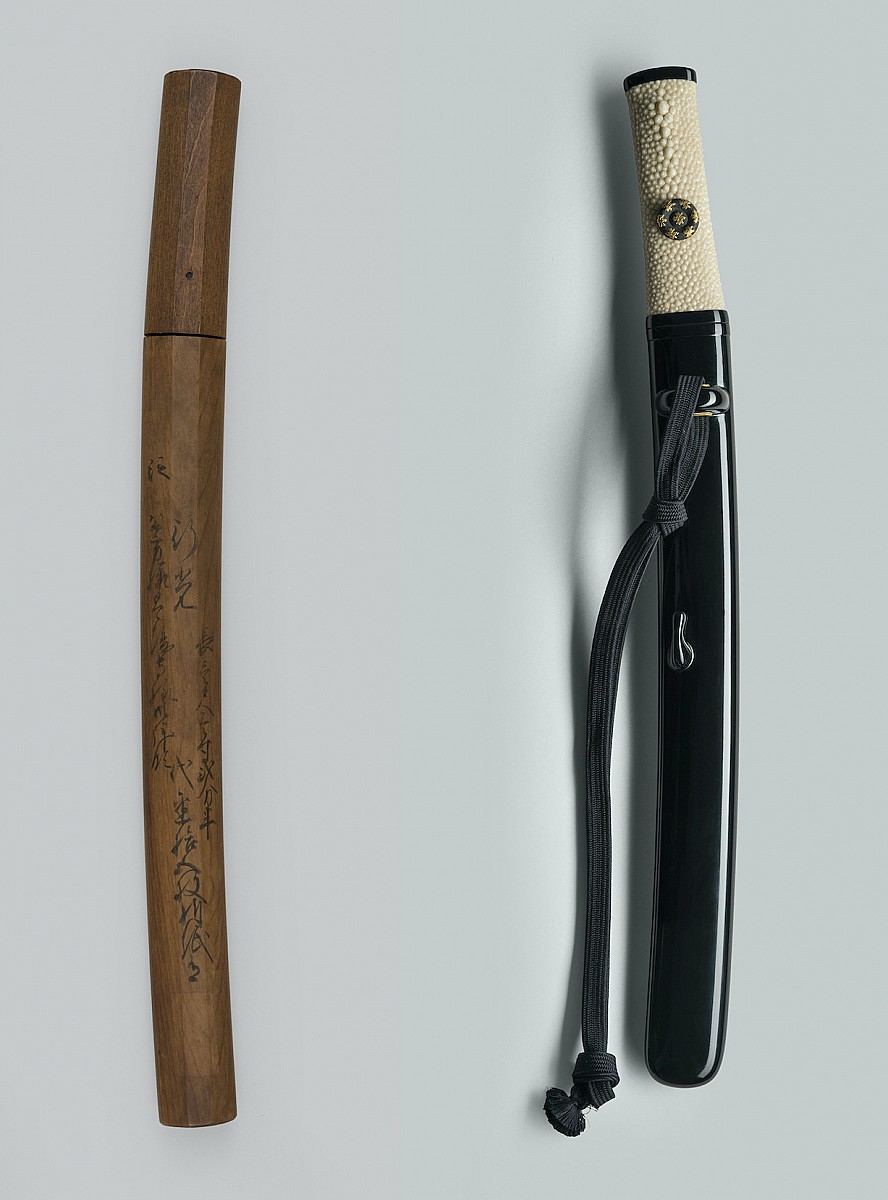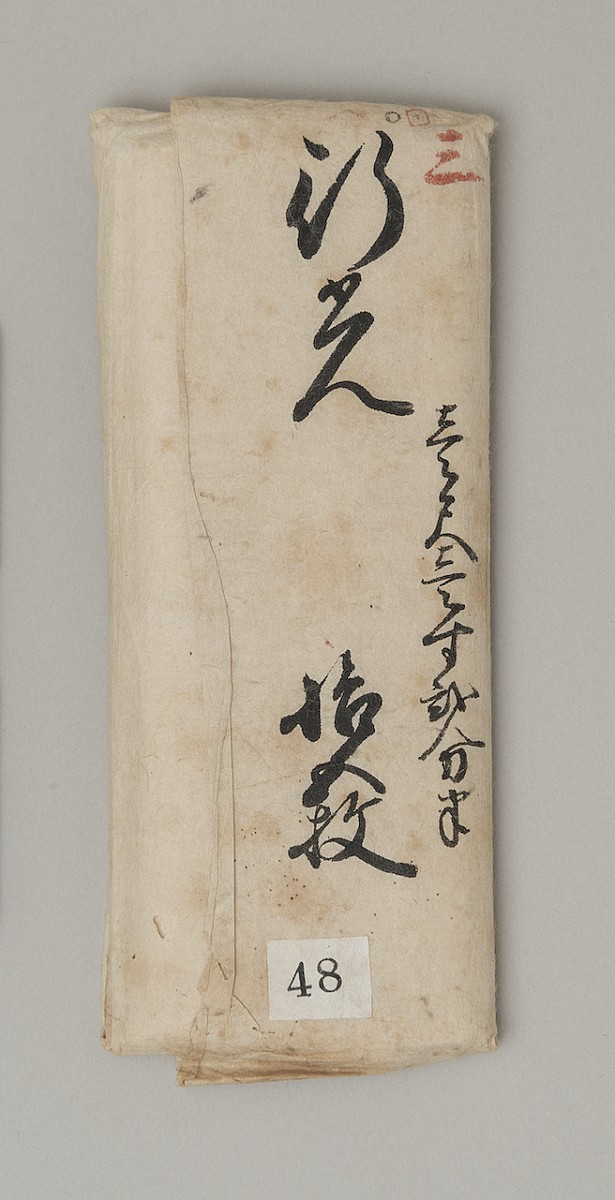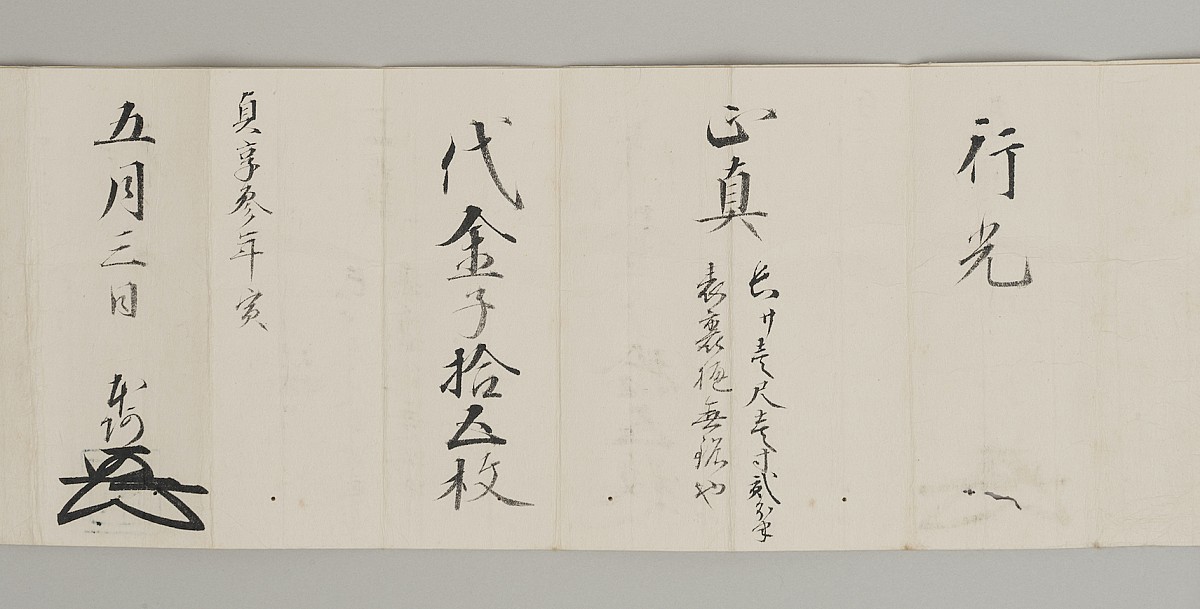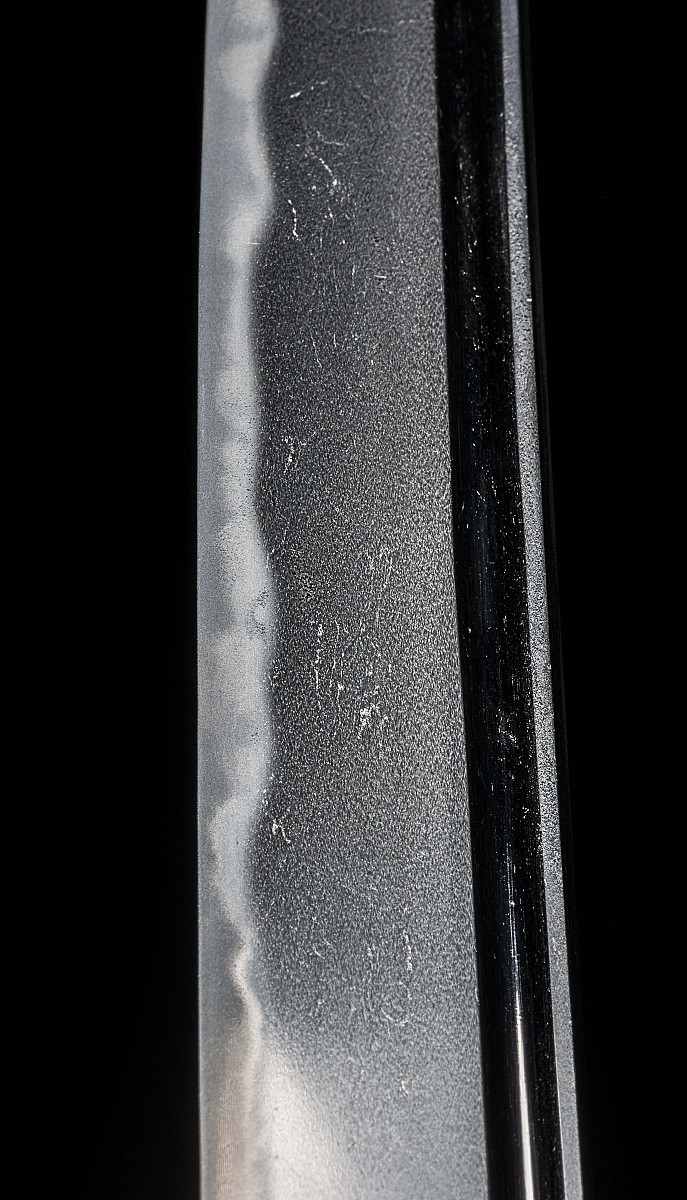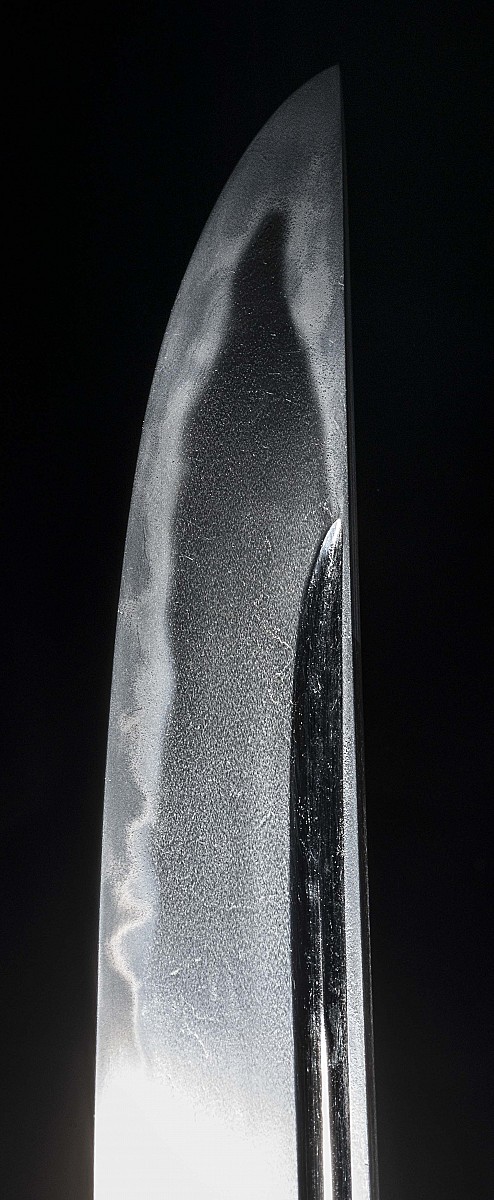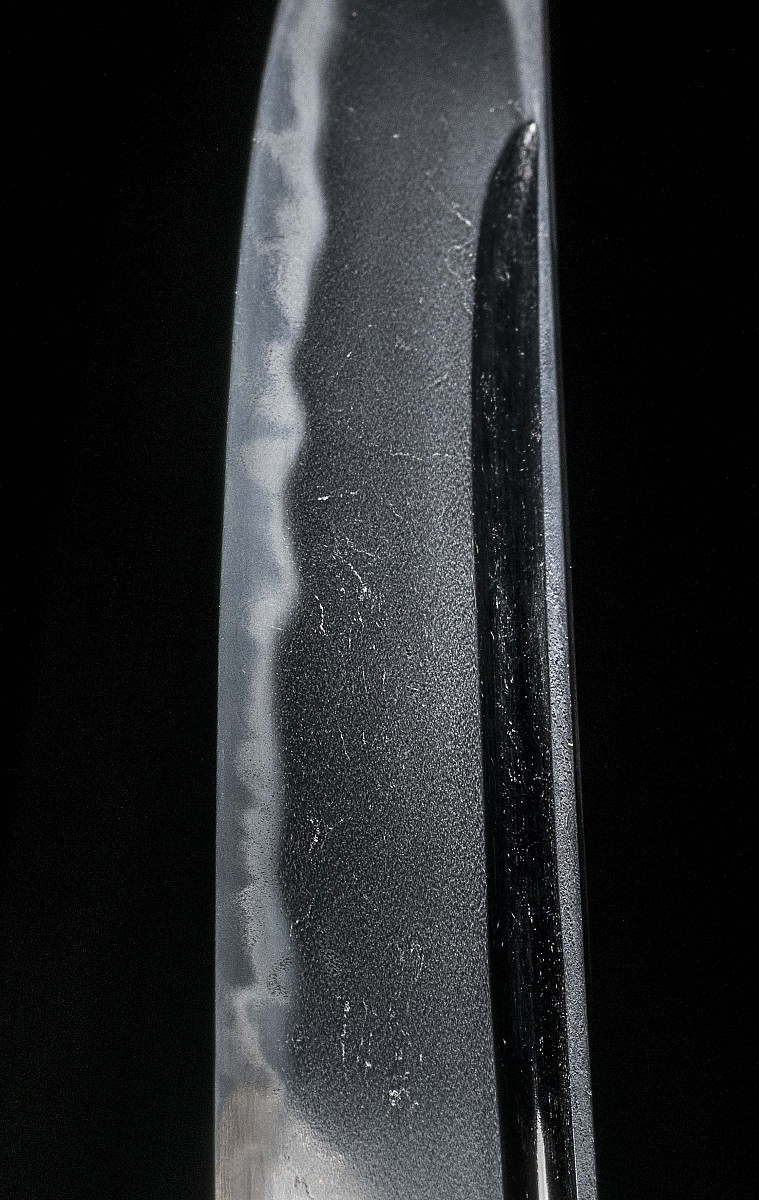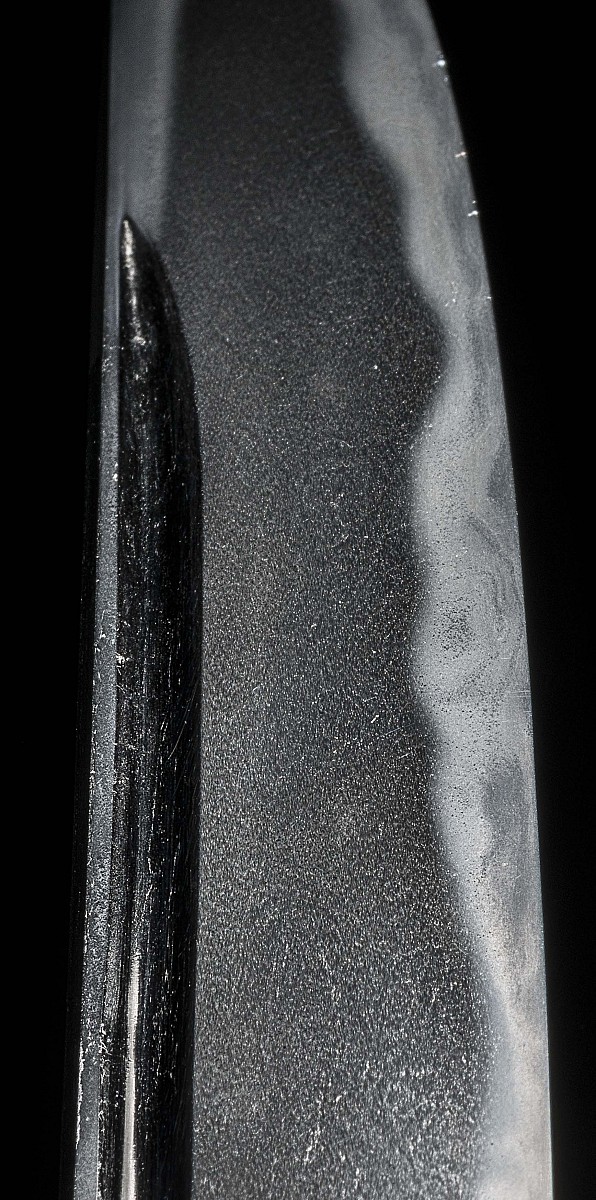Yukimitsu (行光), Kagen (嘉元, 1303-1306), Sagami, his first name was Tōzaburō (藤三郎), according to transmission the son and/or student of Shintōgo Kunimitsu, traditionally his activity period is dated between Kagen (嘉元, 1303-1306) and Kenmu (建武, 1334-1338). Yukimitsu displayed the most Sōshū typical workmanship of all early Sōshū smiths and so he is named as founder of the Sōshū tradition by some who want to nail the founding down to an individual smith, in general we can say that he was quasi the link from the Awataguchi school over Shintōgo Kunimitsu to the fully developed Sōshū style at Masamune and Sadamune, it is also said that he was the younger brother of Daishinbō (大進房), publications like the Kōsei-kotō-meikan (校正古刀銘鑑) and the Nōami-bon mei-zukushi (能阿弥本銘尽) say that there were two generations Yukimitsu active, but this is dismissed in the meanwhile. Tokaido (東海道), saijō-saku.
Jūyō Tōken Yukimitsu Wakizashi: nagasa: 34.0 сm; sori: 0.2 сm; motohaba: 3.0 сm; nakago nagasa: 9.0 сm; nakago sori: none. The sword is unsigned, kinpun-mei “Yuki Mitsu” on the omote side, by Hon’ami Kōson, shu-mei “origami of the 5th month of the year 1686, valued at 15 mai” on the ura side by Hon’ami Kōson, nakago ubu, origami Hon’ami Kōjō, 1686, sayagaki on the old shirasaya by Hon’ami, sayagaki on the new shirasaya by Tanobe Michihiro (Tanzan), 2014. Provenance: Tokugawa Shōgunate, Bungo no Kami Yorimichi (豊後守頼通), Kurakawa Museum (city of Kobe), Matsueda Teruhiro (松枝輝博), and Kurokawa Seikichi (黒川精吉, owner of “Sōkendō”). The sword is presented with an authentic koshirae made in the Edo period.
Designated as Jūyō Tōken at the 39th jūyō-shinsa held on the 5th of November 1993.
Publications: NBTHK Jūyō Tōken Nado Zufu, Volume 39, “Tokugawa Chronicles” (Albert Yamanaka’s Nihontō Newsletter, Volume 4, San Francisco, 1994–2004), p. 331.

Figure 1. Albert Yamanaka’s Nihontō Newsletter.
This sword is most likely one of the late works by Yukimitsu, where we can see the influence of a trend of increasing the size of tantō that emerged in the period of Nanbokuchō. This sword clearly shows the influence of Sadamune and is yet another confirmation of Yukimitsu’s skill and variety. In addition, this is a vivid example of tantō elongation and the transition to the category of wakizashi. In other words, tantō are shorter than wakizashi, and at a certain point, when a tantō is lengthened enough, it can no longer be called a tantō but is actually more like a wakizashi. Moreover, there is the appearance of blade curvature, which was initially small and barely noticeable. For this reason, this sword is an important example of Yukimitsu’s forging skill, dating back to the late period of his creative output. It was one of the initial steps in the revolution in tantō manufacturing advanced by Sadamune, Hiromitsu, and Akihiro, who defined the new type of short sword for many years to come.
Numerous examples from the “Tokugawa Chronicles” are repeatedly cited in this book, which describe the donation of swords during official ceremonies. The chronicles contain thousands of such events, mentioning a fairly large number of swords. However, these chronicles specify only the type of sword and the name of the smith who forged it, with no details about the length of the nagasa or any other quantitative data. This information is clearly not sufficient to determine the type of each sword and especially to document its relationship to a modern one. That would require a unique combination of circumstances and the availability of relevant records in clan archives and chronicles, which are often more detailed than the “Tokugawa Chronicles.”

Figure 2. Albert Yamanaka (1922-1983).
The donation of the wakizashi presented here, made by Yukimitsu, provides a very rare opportunity to define an event described in the “Tokugawa Chronicles” and allows us to unequivocally identify the sword that was involved in this event. This Yukimitsu wakizashi has an old shirasaya with a sayagaki written by the Hon’ami in the mid-Edo period. Unfortunately, the sayagaki has neither the individual name of the Hon’ami who wrote it nor the date when it was made. Nevertheless, there are good reasons to assume that the appraisal could have been made by the same expert who issued an origami to this sword: Hon’ami Kōjō. The sayagaki has the following text: 行光。長壱尺壱寸貳分半。 代金拾五枚折紙有。従 公方様豊後守御拝領。It can be translated as: “Yukimitsu. Nagasa 1 shaku, 1 sun, 2.5 bu. Comes with an origami giving it the value of 15 gold coins (mai). Bungo no Kami received this blade as a gift from the Tokugawa Shōgunate”
Hon’ami Kōjō (本阿弥光常, 1643–1710) was a representative of the main branch of the clan in the 12th generation. He bore the name given to him at his birth, Saburōbei (三郎兵衛), and was an appraiser of a very high class and one of the so-called good Hon’ami.
The “Tokugawa Chronicles” describe only one event in which Bungo no Kami and wakizashi Yukimitsu are mentioned:
“On April 11, 1697, the shōgun visited Lord Kii Dainagōn Mitsusada. During the banquet in his residence, they exchanged gifts, and . . . Bungo no Kami Yorimichi received a Yukimitsu wakizashi as a gift from the shōgun.” [Tokugawa Tsunayoshi (徳川綱吉, February 23, 1646 – February 19, 1709) was the fifth shōgun of the Tokugawa dynasty from 1680 until 1709].

Figure 3. Tokugawa Tsunayoshi.
It is known that Bungo no Kami Yorimichi (Matsudaira Yorimichi, 1661–1698) was a cousin of Tokugawa Yoshimune (the 8th shōgun). Quite often, sayagaki written by Hon’ami provide important data about a relevant sword, such as its belonging to the family important events that occurred involving the sword. Therefore, old shirasaya with sayagaki may be considered the equivalent of historic documents, which contain reliable data. It is extremely fortunate if the details of such data coincide with information provided in other sources. For example, as in the case of this Yukimitsu wakizashi, data from sayagaki fully coincides with the event described in the chronicles. Therefore, this case, which allows us to trace the history of the sword during the Edo period, is unique.
Another interesting fact pertains to the combination of two different types of kiwame (極め)—kinpun-mei and shu-mei—on one tang of the same sword, which are almost impossible to find together. There are only five other swords, in addition to this Yukimitsu wakizashi, in which we can see these two types of attributes at the same time. Therefore, such examples are considered extremely rare.
This Yukimitsu wakizashi has a relatively low valuation in gold coins (although it is unattainable for many swords). However, one must keep in mind that these figures belong to an old valuation method used by Hon’ami, which was based on recommendations provided in the Kokon Meizukushi Taizen. Only later appraisers began to operate with higher figures. The availability of an old extant origami by Hon’ami and kinpun-mei Hon’ami allowed modern NBTHK experts to directly attribute this work to Yukimitsu. The origami by Hon’ami Kōjō is very valuable in itself, due to the fact that its author was a representative of the main line of Hon’ami, who was considered a very good expert and connoisseur of swords. This is a very old, rare origami, because few expert documents have survived from those times to the present day. We can read in the origami for this sword: 行光。正真。長サ壱尺壱寸貮分有。表裏樋無銘也。代金子拾五枚。貞享参年寅。五月三日。本阿。 “Yukimitsu. Shōshin (authentic). Nagasa 1 shaku 1 sun 2 bu ari (~ 34.0 cm). On both sides hi, mumei. Value 15 gold pieces. Jōkyō three [1686], Year of the Tiger, fifth day, third month. Hon ́a + Kaō.”
A personal monogram in this origami belongs to Hon’ami Kōjō (see Figure 3.5, showing the monogram in the previous chapter). The valuation at 15 mai seems rather low for old origami Hon’ami, as mentioned (we can recall the valuation of “Hōchō Masamune” (包丁正宗) at 30 mai in 1654 by Hon’ami Kōōn), whereas later the monetary value of this sword made by Yukimitsu would be much higher.
In 2014, this sword passed an examination by Tanobe sensei, who made a sayagaki on the new shirasaya of the sword. The record turned out to be so long that there was not enough space for it on the omote side; therefore, it was continued on the ura side.
Omote side: 第卅九回重要刀剣指定品。相模国藤原三郎行光。貞享三年本阿弥光常代金子拾五枚折紙付。長壹尺一寸弐分余有之。惟時甲午仲春探山邉道識。Translation: “Designated as Jūyō at the 39th Jūyō-shinsa. Sagami no Kuni Fujiwara Saburō Yukimitsu. Comes with an origami of Hon’ami Kōjō from Jōkyō three (1686), giving the blade a value of 15 gold pieces. Blade length 1 shaku 1 sun 3 bu. Written by Tanzan Hendō [pseudonym of Tanobe Michihiro] in mid-spring of the Year of the Horse of this era (2014) + Kaō.”
Ura side: 生茎無銘ニ本阿弥光遜ガ古極ガアル旨ヲ金粉ト朱デ誌ヒリ古来同工ノ作域ハ多岐ニ且ルトサレ本作ハ飛焼ヤ湯走ヲ交ヘタ互乃目調ノ乱ヲ焼キ地刃ニ沸ノ自在ノ変化ヲ現シ所傅ハ首肯サレ珍重然ルベキ哉。 Translation: (the translation is given in the Japanese Swords: Sōshū-den Masterpieces book).
(excerpt from Chapter 4, pp. 60-105, of the Japanese Swords: Sōshū-den Masterpieces )

